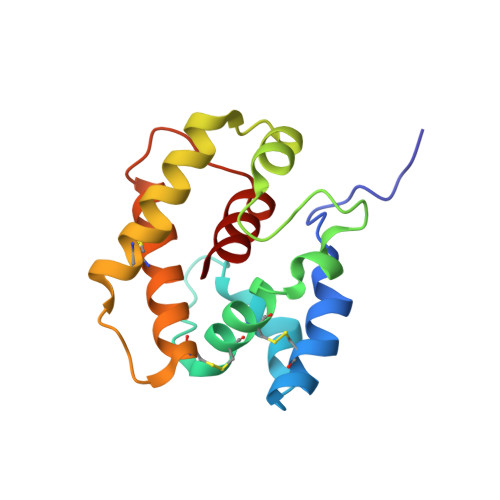NMR Structure Reveals Novel Intramolecular Regulation Mechanism for Pheromone-Binding and Release
Horst, R., Damberger, F., Luginbuhl, P., Guntert, P., Peng, G., Nikonova, L., Leal, W.S., Wuthrich, K.(2001) Proc Natl Acad Sci U S A 98: 14374-14379
- PubMed: 11724947
- DOI: https://doi.org/10.1073/pnas.251532998
- Primary Citation of Related Structures:
1GM0 - PubMed Abstract:
Odorants are transmitted by small hydrophobic molecules that cross the aqueous sensillar lymph surrounding the dendrites of the olfactory neurons to stimulate the olfactory receptors. In insects, the transport of pheromones, which are a special class of odorants, is mediated by pheromone-binding proteins (PBPs), which occur at high concentrations in the sensillar lymph. The PBP from the silk moth Bombyx mori (BmPBP) undergoes a pH-dependent conformational transition between the forms BmPBP(A) present at pH 4.5 and BmPBP(B) present at pH 6.5. Here, we describe the NMR structure of BmPBP(A), which consists of a tightly packed arrangement of seven alpha-helices linked by well defined peptide segments and knitted together by three disulfide bridges. A scaffold of four alpha-helices that forms the ligand binding site in the crystal structure of a BmPBP-pheromone complex is preserved in BmPBP(A). The C-terminal dodecapeptide segment, which is in an extended conformation and located on the protein surface in the pheromone complex, forms a regular helix, alpha(7), which is located in the pheromone-binding site in the core of the unliganded BmPBP(A). Because investigations by others indicate that the pH value near the membrane surface is reduced with respect to the bulk sensillar lymph, the pH-dependent conformational transition of BmPBP suggests a novel physiological mechanism of intramolecular regulation of protein function, with the formation of alpha(7) triggering the release of the pheromone from BmPBP to the membrane-standing receptor.
- Institut für Molekularbiologie und Biophysik, Eidgenössische Technische Hochschule, CH-8093 Zürich, Switzerland.
Organizational Affiliation:
















